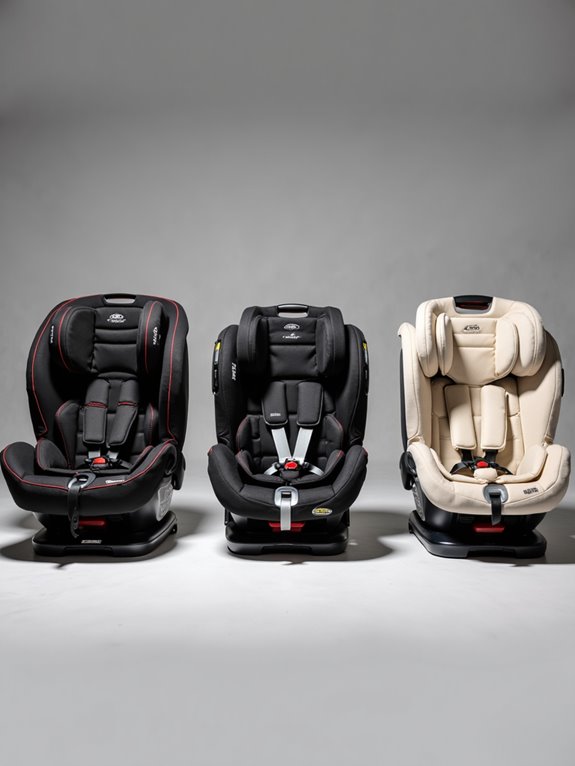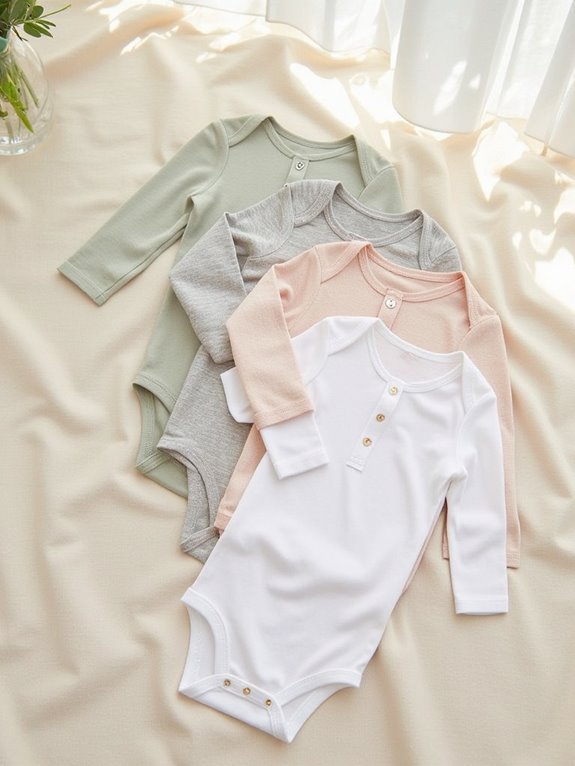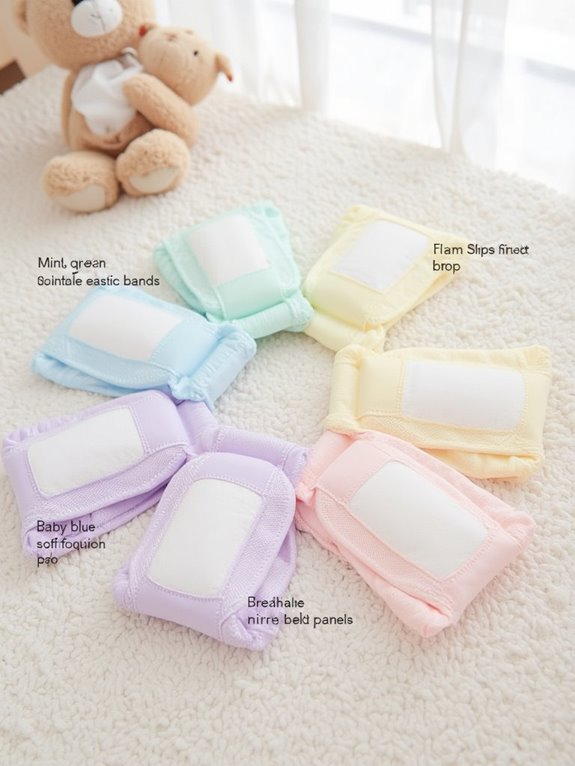Links below are affiliate links. We earn a commission on purchases at no extra cost to you. Although our opinions are based on curated research, we haven't used these products. Articles generated with AI.

The 3 Best Baby Car Seats of 2025, According to Safety Experts
Safety experts recommend three top car seats for 2025: The Safety 1st Guide Convertible (fits 3 across, 5-65 lbs), the ultra-portable Graco SnugRide Lite LX (7.2 lbs, supports 4-30 lbs), and the Britax One4Life Convertible (5-120 lbs with 15 recline positions). All three exceed federal safety standards with enhanced side-impact protection, adjustable features for growing children, and machine-washable covers. Below, you’ll discover specific installation methods and compatibility details for each model.
Key Takeaways
- The Britax One4Life leads safety rankings with its 10-year lifespan, 120-pound capacity, and 15 recline positions for optimal safety.
- Safety 1st Guide excels in space efficiency, fitting three seats across most vehicles while maintaining high safety standards.
- Graco SnugRide Lite LX offers superior portability at 7.2 pounds with comprehensive crash protection through ProtectPlus Engineering.
- All top-rated seats exceed FMVSS 213 safety standards and feature advanced side-impact protection and energy-absorbing materials.
- Leading models include machine-washable covers, adjustable headrests, and steel-reinforced frames for long-term durability and safety.
Safety 1st Guide Convertible Car Seat (Fits 3 Across)
Sale
Safety 1st Guide Convertible Car Seat, Fits 3 Across, Forward Facing and Rear Facing, Chambers
- FITS 3 ACROSS: The slim car seat design is great for small cars, allowing you to fit three of these baby car seats to big kid forward-facing seat across in the back seat...
- CAR SEAT FOR BABY TO BIG KID: Enjoy longevity of use with this 2-in-1 rear-facing to forward-facing convertible car seat. Use rear-facing for babies from 5–40 lbs. and...
- EASY TO INSTALL: The Guide convertible carseat for babies and toddlers is LATCH equipped for easy and fast installation. This convertible carseat for use in rear-facing...
If you’re looking to fit multiple car seats in your vehicle while maintaining top safety standards, the Safety 1st Guide Convertible Car Seat stands out as a space-efficient solution. This versatile seat accommodates children from 5 to 65 pounds and up to 52 inches tall.
Key Features:
- Rear-facing: 5-40 lbs. (19-40 inches)
- Forward-facing: 22-65 lbs. (34-52 inches)
- 5-point harness with easy tightening
- LATCH installation system
- 5 recline positions
- Side-impact protection
At just 11.53 pounds, you’ll find it’s lightweight and easy to install. The slim design lets you fit three seats across most vehicles, making it ideal for growing families or carpooling. With over 4,400 reviews and a 4.5-star rating, it’s proven reliable and cost-effective.
Best For: Parents needing to fit multiple car seats in one vehicle, families with children of different ages, or those wanting a long-lasting convertible car seat that combines safety with space efficiency.
Pros:
- Slim design allows three seats to fit across most vehicle back seats
- Versatile weight range (5-65 lbs) with both rear and forward-facing capabilities
- Excellent value for money with high safety standards and comfort features
Cons:
- May require additional accessories for ISOFIX installation
- Some users report the straps can be tricky to tighten properly
- Cup holder design could be more sturdy and convenient
Graco SnugRide Lite LX Infant Car Seat, Studio
Graco SnugRide Lite LX Infant Car Seat, Rear-Facing, Lightweight, Adjustable Base, Easy Install,...
- Infant car seat helps protect rear-facing infants 4-30 lb and up to 32"
- Lightweight infant car seat weighs only 7.2 lb, making it easy to carry baby from car to stroller
- 4-position adjustable base helps ensure an accurate install and helps keep baby comfortable as he or she grows
Parents seeking the perfect balance of safety and portability will find the Graco SnugRide Lite LX Infant Car Seat an exceptional choice for 2025. At just 7.2 pounds, it’s remarkably lightweight while supporting infants from 4 to 30 pounds and up to 32 inches tall.
The seat’s Graco ProtectPlus Engineering means it’s tested for all crash types: frontal, side, rear, and rollover. You’ll get essential safety features like a 5-point harness and 4-position adjustable base with level indicator. The seat connects easily to most Graco strollers, and its soft knit supports are removable as your baby grows.
Best For: Parents prioritizing a lightweight, safety-tested infant car seat that’s easy to transport and compatible with Graco strollers.
Pros:
- Exceptionally lightweight at 7.2 pounds, making it easy to carry and transfer
- Comprehensive safety testing with ProtectPlus Engineering for all crash types
- Versatile compatibility with most Graco strollers and adjustable features that grow with baby
Cons:
- Some users report stickiness in the handle adjustment button
- Maximum weight limit of 30 pounds is lower than some competing models
- Base requires separate purchase for additional vehicles
Britax One4Life Convertible Car Seat (5-120 lbs)
Britax One4Life Convertible Infant Car Seat, 10 Years of Use from 5 to 120 Pounds, Converts from...
- 10 YEARS OF USE: The Britax One4Life all-in-one car seat delivers comfort and security from 5 to 120 pounds and up to 63 inches tall
- ONE CAR SEAT FOR LIFE: This car seat features 4 configurations, including rear facing infant car seat, rear facing toddler car seat, forward facing 5 point harness car...
- INSTALL WITH CONFIDENCE: ClickTight(R) technology makes installation easy – simply open the seat, thread and buckle the seatbelt, and click the seat closed
The Britax One4Life stands out as a premium choice for families seeking a single car seat to last through their child’s entire car seat journey. You’ll get 10 years of use from 5-120 pounds, with four configurations to match your child’s growth.
The seat’s ClickTight installation system guarantees secure fitting in three simple steps. Safety features include:
- High-strength steel frame
- SafeCell crumple zone
- V-shaped tether
- Side-impact protection
Your child will stay comfortable with 15 recline positions and a foam-lined headrest. The machine-washable cover and no-rethread harness make maintenance simple. With a 4.7/5 rating from over 1,000 reviews, this seat delivers on both safety and convenience.
Best For: Parents seeking a premium, long-term investment in a single car seat that will safely accommodate their child from infancy through school age (5-120 lbs).
Pros:
- Industry-leading ClickTight installation system ensures secure, foolproof fitting every time
- Exceptional 10-year lifespan with four different configurations to grow with your child
- Comprehensive safety features including steel frame, crumple zones, and side-impact protection
Cons:
- Higher price point compared to basic car seats or non-convertible options
- Bulky size and heavy weight (30+ lbs) can make transfers between vehicles challenging
- May be too wide for fitting three car seats across in smaller vehicles
Factors to Consider When Choosing a Baby Car Seat

When you’re selecting a baby car seat, you’ll need to match your child’s age and weight with the seat’s specifications while ensuring it meets current safety certification standards. Your choice should factor in how easily the seat installs in your specific vehicle, including whether you’ll use the LATCH system or seat belt installation method. The seat’s ability to adapt as your child grows through different stages is essential, with features like adjustable headrests, harness positions, and convertible designs offering long-term value for your investment.
Age and Weight Range
Selecting an age-appropriate car seat stands as one of the most critical safety decisions you’ll make for your child. You’ll need to match your child’s current measurements with the seat’s specifications while allowing room for growth.
Key Weight Ranges:
- Infant seats: 4-35 pounds
- Convertible seats: 5-65+ pounds
When evaluating car seats, you’ll want to check both minimum and maximum limits:
- Weight capacity
- Height restrictions
- Age recommendations
Your child’s safety depends on using a seat within its designated range. Don’t be tempted to use a seat that’s too big or small – this can compromise protection and violate safety regulations. Many modern seats offer adjustable features to accommodate growth, but you’ll still need to verify that your child fits within the manufacturer’s specified limits.
Safety Certification Standards
Safety certification standards serve as your primary guarantee that a car seat will protect your child in a crash. When selecting a car seat, you’ll want to verify it meets or exceeds FMVSS 213 requirements, which involve extensive crash testing across multiple collision scenarios.
Key Certification Requirements:
- Extensive crash testing (frontal, side, rear, rollover)
- Energy absorption capabilities
- Structural integrity evaluation
- LATCH system compatibility
- Side-impact protection testing
Before purchasing, always check the safety certification label on the seat. You’ll find a date stamp and compliance information that should match current regional regulations. Modern certified seats must demonstrate their ability to properly restrain your child while maintaining structural integrity during impacts. Don’t compromise on these standards – they’re backed by rigorous testing protocols designed to save lives.
Installation Method Options
Modern car seats come with multiple installation options to accommodate different vehicle configurations and safety preferences. You’ll typically have two main choices for securing your car seat:
- LATCH/ISOFIX System
- Uses built-in anchors and tethers
- Often provides the most secure fit
- Look for color-coded indicators for correct attachment
- Seat Belt Installation
- Compatible with all vehicle types
- Requires proper belt-locking mechanism
- Check for level indicators during setup
When installing your seat, you’ll need to:
- Choose rear-facing position for infants and small children
- Adjust the recline angle using included indicators
- Ensure the seat doesn’t move more than one inch in any direction
- Test all connections for tightness and security
- Verify locking mechanisms are fully engaged
Vehicle Size Compatibility
When choosing a baby car seat, your vehicle’s size plays a crucial role in determining which models will fit safely and securely. You’ll need to measure your car’s interior dimensions carefully, including the width between seats and available legroom, before making a purchase.
Key Measurements to Take into Account:
- Back seat width for multiple car seat installations
- Space between front and back seats
- LATCH anchor locations
- Seat belt pathway accessibility
For smaller vehicles or compact cars, you’ll want to focus on slim-profile car seats that don’t compromise safety. Check the car seat’s specifications to verify it matches your vehicle’s dimensions and weight limits. The manufacturer’s guidelines will help you confirm if the seat’s installation method is compatible with your car’s restraint systems.
Growth Adaptability Features
As your child rapidly grows during their first few years, investing in a car seat with robust growth adaptability features can provide long-term value and consistent protection.
Today’s leading car seats offer multi-stage configurations that’ll serve your child from infancy through early childhood. You’ll want to look for:
- Adjustable headrests and harness heights that move up as your child grows
- Convertible designs that transition from rear-facing to forward-facing positions
- Removable infant inserts for a snug fit during the earliest months
- Multiple recline positions to support proper posture at different stages
- Extended weight and height limits (typically 4-65 pounds)
These adaptable features ensure you won’t need to purchase multiple seats, while maintaining ideal safety standards as your child develops. Look for easy-to-adjust straps and clear height indicators for precise positioning.
Comfort and Support Design
The ultimate safety of your child depends greatly on their comfort level during car rides, making proper support design a critical factor in car seat selection. When evaluating comfort features, you’ll want to focus on these key elements:
- Padding and Materials: Look for seats with soft, cushioned fabrics and adjustable headrests that accommodate your child’s growth.
- Support Systems: Choose models with robust side-impact protection and secure harness designs that keep your child properly positioned.
- Adjustability: Select seats offering multiple recline positions to ensure ideal comfort during extended trips.
- Maintenance: Opt for models with removable, machine-washable covers to maintain cleanliness.
- Ergonomic Design: Prioritize seats with contoured surfaces that support natural body alignment, reducing fatigue and providing enhanced comfort during travel.
These comfort features work together to create a secure, enjoyable riding experience for your child.
Travel System Integration
Modern travel systems have revolutionized how parents transport their little ones between vehicles and strollers. When you’re selecting a car seat for travel system compatibility, you’ll need to verify that your chosen models work together seamlessly.
Key Integration Factors to Consider:
- Compatibility verification between specific car seat and stroller models
- One-handed attachment/detachment mechanism
- Combined weight of car seat and stroller system
- 360-degree rotating canopy functionality
- Secure locking indicators
You’ll want to focus on systems that offer smooth changes without disturbing your sleeping baby. Look for clear “click” sounds that confirm proper attachment, and test the release mechanisms before purchase. The best travel systems let you transfer your infant from car to stroller without any awkward twisting or complicated maneuvers, helping you maintain proper posture during transitions.
Material and Durability
Selecting materials that guarantee your child’s safety represents one of the most crucial decisions when choosing a car seat. You’ll want to focus on two key aspects: structural integrity and comfort durability.
Primary Safety Materials:
- Impact-resistant reinforced plastic shell
- Steel-reinforced frame components
- Flame-retardant materials meeting current standards
- Reinforced harness attachment points
Durability Features:
- Heavy-duty fabric covers with stain resistance
- Double-stitched seams for extended wear
- Easy-clean surfaces that withstand repeated washing
- Crack-resistant frame construction
When evaluating car seats, inspect the overall build quality. Look for solid construction throughout, especially at stress points where components connect. The materials shouldn’t feel flimsy or show signs of weakness. Remember, superior materials directly contribute to your child’s protection during impacts while ensuring the seat maintains its integrity through years of use.
Frequently Asked Questions
How Do I Know When It’s Time to Replace My Baby’s Car Seat?
Like a stoplight turning yellow, several clear signals indicate it’s time to replace your baby’s car seat:
- Your child has exceeded the seat’s height or weight limits
- The seat has passed its expiration date (typically 6-10 years from manufacture)
- The seat’s been in a moderate or severe crash
- You notice visible cracks, fraying straps, or broken parts
- The base is loose or wobbles when installed
Check your seat’s label for specific limits and dates.
Can I Use a Second-Hand Car Seat From a Trusted Friend?
While it may seem economical, you shouldn’t use a second-hand car seat unless you know its complete history. Even from a trusted friend, used car seats can have hidden damage or expired safety standards. You can’t be certain if it’s been in an accident, which compromises structural integrity. Additionally, safety technology and regulations change frequently. For your baby’s safety, it’s best to purchase a new car seat with current safety features and certifications.
What’s the Proper Way to Clean and Maintain a Car Seat?
To properly clean and maintain your car seat:
- Remove the cover following manufacturer’s instructions and machine wash in cold water on gentle cycle
- Air dry the cover completely before reassembling
- Clean plastic and metal parts with mild soap and warm water
- Never use harsh chemicals or bleach
- Check straps for wear and wipe them with damp cloth only
- Inspect buckles and connections monthly
- Follow your manual’s maintenance schedule
- Store in a dry place when not in use
Are Car Seats Allowed on Airplanes During Travel?
Yes, you can bring your child’s car seat on most commercial flights, but there’s more you’ll need to know. First, check that your seat is FAA-approved (look for the sticker). You’ll also need to purchase a ticket for your child to use it onboard. Window seats are required for car seat installation, and your seat must not block other passengers’ evacuation path. Contact your airline beforehand to confirm their specific requirements.
How Long Should a Baby Stay in a Rear-Facing Position?
You should keep your baby in a rear-facing car seat as long as possible – ideally until they reach the maximum height or weight limit of their seat. The American Academy of Pediatrics recommends rear-facing until at least age 2, but many children can stay rear-facing until age 4. Check your car seat’s manual for specific limits. Rear-facing provides vital protection for your baby’s head, neck, and spine in the event of a crash.







